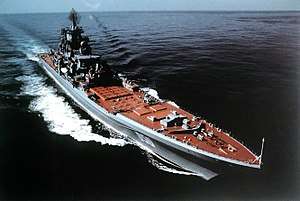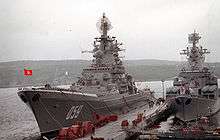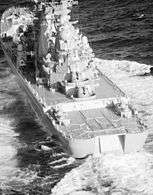Kirov-class battlecruiser
 Kirov-class battlecruiser Frunze | |
| Class overview | |
|---|---|
| Builders: | Baltic Shipyard, Leningrad |
| Operators: | |
| Built: | 1974–1998 |
| In service: | 1980-present |
| Planned: | 5 |
| Completed: | 4 |
| Cancelled: | 1 |
| Active: | 1 (1 undergoing refit) |
| Laid up: | 2 |
| General characteristics | |
| Type: | Heavy guided missile cruiser/battlecruiser with nuclear marine propulsion |
| Displacement: |
|
| Length: | 252 m (827 ft) |
| Beam: | 28.5 m (94 ft) |
| Draft: | 9.1 m (30 ft) |
| Propulsion: |
|
| Speed: | 32 knots (59 km/h; 37 mph) |
| Range: |
|
| Complement: | 710 |
| Sensors and processing systems: |
|
| Electronic warfare & decoys: | 2 × PK-2 Decoy dispensers (400 rockets) |
| Armament: |
|
| Armour: | 76 mm plating around reactor compartment, light splinter protection |
| Aircraft carried: | 3 helicopters |
| Aviation facilities: | Below-deck hangar |
The Kirov-class battlecruiser is a class of nuclear-powered warship of the Russian Navy, the largest and heaviest surface combatant warships (i.e. not an aircraft carrier or amphibious assault ship) in operation in the world. Among modern warships, they are second in size only to large aircraft carriers, and of similar size to a World War I era battleship. The official designation of the ship-type is "heavy nuclear-powered guided missile cruiser" (Russian: тяжёлый атомный ракетный крейсер). The ships are often referred to as battlecruisers by western defense commentators due to their size and general appearance.[3]
Originally built for the Soviet Navy, the class is named for the first of a series of four ships to be constructed, Kirov, which was renamed Admiral Ushakov in 1992. Original plans called for the construction of five ships, however the last was cancelled. In Russia this class of ship is usually referred to by the designation Project 1144 Orlan (sea eagle). Only Pyotr Velikiy is currently operational. Admiral Nakhimov is projected to re-enter the Russian Navy in 2018. Russia planned to reactivate the remaining two vessels by 2020,[2][4] but recent reporting suggests that the reactors in Admiral Ushakov and Admiral Lazarev are in a poor condition, and these ships cannot be safely reactivated.[5][6]
The appearance of the Kirov class played a key role in the recommissioning of the Iowa-class battleships by the United States Navy in the 1980s.[7][8][9]
The Kirov hull design also was used for the nuclear-powered SSV-33 command ship Ural.
Design
Armament

The Kirov class's main weapons are 20 P-700 Granit (SS-N-19 Shipwreck) missiles mounted in deck, designed to engage large surface targets. Air defense is provided by twelve octuple S-300F launchers with 96 missiles and a pair of Osa-MA batteries with 20 missiles each. Pyotr Velikiy carries some S-300FM missiles and is the only ship in the Russian Navy capable of ballistic missile defence.[2] The ships had some differences in sensor and weapons suites: Kirov came with SS-N-14 anti-submarine warfare (ASW) missiles, while on subsequent ships these were replaced with 9K331 Tor surface-to-air missile (SAM) systems. The Tor installation is in fact mounted further forward of the old SS-N-14 mounting, in the structure directly behind the blast shield for the bow mounted RBU ASW rocket launcher. Kirov and Frunze had eight 30 mm (1.18 in) AK-630 close-in weapon systems, which were supplanted with the Kashtan air-defence system on later ships.
Other weapons are the automatic 130 mm (5 in) AK-130 gun system (except in Kirov which had two single 100 mm (4 in) guns instead), 10 21-inch (533 mm) torpedo/missile tubes (capable of firing SS-N-15 ASW missiles on later ships) and Udav-1 with 40 anti-submarine rockets and two sextuple RBU-1000 launchers.
Russia is developing a new anti-ship missile to equip Kirovs called the 3M22 Tsirkon, which is capable of traveling at hypersonic speeds out to at least 620 mi (540 nmi; 1,000 km).[10][11] If the missile passes developmental tests, it could enter service in 2020, being deployed first aboard Admiral Nakhimov and later in Pyotr Veliky when it finishes upgrades in 2022.[12][13] Depending on the choice of types of missiles will amount to 40 - 80.[14]
| Kirov / Admiral Ushakov | Frunze / Admiral Lazarev | Kalinin / Admiral Nakhimov | Yuri Andropov / Pyotr Velikiy | |
|---|---|---|---|---|
| Anti-ship missiles | 20 x SS-N-19 Shipwreck | |||
| Anti-submarine missiles | 1 x twin SS-N-14 Silex | |||
| SS-N-15 Starfish (via 533mm torpedo tube) | ||||
| Surface-to-air missiles | 12 x 8 SA-N-6 Grumble | 6 x 8 SA-N-6 Grumble | ||
| 6 x 8 SA-N-20 Gargoyle | ||||
| 2 x 20 SA-N-4 Gecko | ||||
| 16 x 8 SA-N-9 Gauntlet | ||||
| Guns | 2 x 1 AK-100 100 mm | 1 x 2 AK-130 130 mm | ||
| CIWS | 8 x AK-630 | 6 x CADS-N-1 | ||
| Antisubmarine rockets | 2 x RBU-1000 | |||
| 2 x RBU-12000 | ||||
| Torpedo tubes | 10 x 533mm torpedo tubes for Type 53 | |||
Fire control

- 2 × Top Dome for SA-N-6 fire control radar (the forward Top Dome is replaced with Tomb Stone (Passive electronically scanned array) in Pyotr Veliky)
- 4 × Bass Tilt for AK-360 CIWS System fire control (not in Admiral Nakhimov or Pyotr Veliky)
- 2 × Eye Bowl for SA-N-4 fire control (also for SS-N-14 in Admiral Ushakov)
- 2 × Hot Flash/Hot Spot for SA-N-11 Grisom (CADS-N-1 units only)
- 1 × Kite Screech for AK-100 or AK-130
- 2 × Cross Sword for SA-N-9 (Gauntlet-equipped units only)

Deployment

The lead ship, Kirov (renamed Admiral Ushakov in 1992 after the dissolution of the Soviet Union) was laid down in June 1973 at Leningrad's Baltiysky Naval Shipyard, launched on 27 December 1977 and commissioned on 30 December 1980. When she appeared for the first time in 1981, NATO observers called her BALCOM I (Baltic Combatant I).
Kirov suffered a reactor accident in 1990 while serving in the Mediterranean Sea. Repairs were never carried out, due to lack of funds and the changing political situation in the Soviet Union.
In 1983, a command and control ship, the SSV-33 Ural was launched, although the ship would not be officially commissioned until 1989. She utilized the basic hull design of the Kirov-class vessels, but with a modified superstructure, different armament, and was intended for a different role within the Soviet Navy. Ural was decommissioned and laid up in 2001, due to high operating costs, and is scheduled to be scrapped in 2017.
Frunze, the second vessel in the class, was commissioned in 1984. She was assigned to the Pacific Fleet. In 1992, she was renamed Admiral Lazarev. The ship became inactive in 1994 and was decommissioned four years later. She is currently in reserve. On 19 September 2009, General Popovkin, Deputy MOD for Armaments, said the MOD is looking into bringing Admiral Lazarev back into service.[15]
Kalinin, now Admiral Nakhimov, was the third ship to enter service, in 1988. She was also assigned to the Northern Fleet. Renamed Admiral Nakhimov, she was mothballed in 1999 and reactivated in 2005. She is in overhaul at Severodvinsk Shipyard.
Construction of the fourth ship, Yuriy Andropov, encountered many delays; her construction was started in 1986 but was not commissioned until 1998. She was renamed Pyotr Veliky (Peter the Great) in 1992.[16] She currently serves as the flagship of the Russian Northern Fleet.
On 23 March 2004, English language press reported the Russian Navy Commander-in-Chief, Fleet Admiral Vladimir Kuroedov said Pyotr Veliky's reactor was in an extremely bad condition and could explode "at any moment", a statement which may have been the result of internal politics within the Russian Navy.[17] The ship was sent to port for a month, and the crew lost one-third of their pay.
A fifth Kirov-class cruiser was planned; originally named Fleet Admiral of the Soviet Union Kuznetsov (also reported as Dzerzhinsky), the ship was never laid down.[16] The name was later changed to Oktyabrskaya Revolutsiya (October Revolution),[18] and then just Kuznetsov;[19] finally, on 4 October 1990, the plan for a fifth ship was abandoned.[16]
Ships
| Name | Namesake | Builder | Laid down | Launched | Commissioned | Status |
|---|---|---|---|---|---|---|
| Admiral Ushakov (ex-Kirov) |
Fyodor Fyodorovich Ushakov | Baltiysky Zavod, Leningrad | 27 March 1974 | 26 December 1977 | 30 December 1980 | Laid up, to be scrapped |
| Admiral Lazarev (ex-Frunze) |
Mikhail Petrovich Lazarev | 27 July 1978 | 26 May 1981 | 31 October 1984 | Laid up, possibility of modernization[20][21] | |
| Admiral Nakhimov (ex-Kalinin) |
Pavel Stepanovich Nakhimov | 17 May 1983 | 25 April 1986 | 30 December 1988 | Undergoing refit[22] | |
| Pyotr Velikiy (ex-Yuriy Andropov) |
Peter the Great | 11 March 1986 | 29 April 1989 | 9 April 1998 | In service with the Northern Fleet | |
| Admiral Flota Sovetskogo Soyuza Kuznetsov (ex-Dzerzhinsky, ex-Oktyabrskaya Revolutsiya) |
Nikolay Gerasimovich Kuznetsov | N/A | Cancelled 4 October 1990 | |||
The Russian Navy initially planned to return both Admiral Ushakov and Admiral Lazarev to service after several years of disuse. It was later indicated that the condition of the reactor cores of both ships was such that it would prove difficult, expensive and potentially dangerous to remove the spent nuclear fuel and repair the cores. As a consequence, it is likely that both ships will be scrapped.[5][6] The modernization of Admiral Ushakov seems unlikely due to an alleged nuclear incident which may have left one of its reactors damaged[23] with scrapping to start in 2016 or later.[24] Other sources disagree, stating that all four ships will be modernized and returned to service.[25] In 2014 some maintenance work was performed on Admiral Lazarev (the only cruiser located in the Pacific).[26][27] Skepticism was expressed regarding the ability of Sevmash shipyard to simultaneously modernize two Kirov-class battlecruisers.[26] Modernization of Admiral Nakhimov is ongoing (to be completed by 2018)[28] with the modernization of Pyotr Velikiy to last from 2018 until 2021.[29]
See also
References
- ↑ Archived April 15, 2009, at the Wayback Machine.
- 1 2 3 4 5 "Russian Warship Tests Missile Defense Capability". RIA Novosti. 20 September 2012.
- ↑ Armi da guerra, De Agostini, Novara, 1985.
- ↑ "Upgraded Nuclear Cruiser to Rejoin Russian Navy in 2018 | Defense". RIA Novosti. 2013-06-13. Archived from the original on 2013-06-15. Retrieved 2014-02-09.
- 1 2 "Shipyard director fears radiation accident". Barentsobserver. Retrieved 14 December 2014.
- 1 2 "Only one nuclear cruiser to be modernized". Barentsobserver. Retrieved 14 December 2014.
- ↑ Middleton, Drew (1981-03-13). "Pentagon likes budget proposal, but questions specifics". The New York Times. p. A14.
- ↑ Bishop, p. 80.
- ↑ Miller and Miller, p. 114.
- ↑ "Ракеты "Циркон" окончательно определили технологическое превосходство России над США — Русская политика". ruspolitica.ru.
- ↑ "Для гиперзвуковых крылатых ракет в России создано принципиально новое топливо". vesti.ru.
- ↑ Russia's Monster Battlecruisers Are Getting Hypersonic Anti-Ship Missiles - Nationalinterest.org, 19 February 2016
- ↑ 3M22 Zircon Hypersonic Missile in Development Testing for Russian Navy Kirov-class Cruiser - Navyrecognition.com, 19 February 2016
- ↑ "В России начались летные испытания гиперзвуковой ракеты "Циркон"". 17 March 2016.
- ↑ Agentsvo Natsionalnykh Novostey (Russian) 19 September 2009
- 1 2 3 Ударные корабли, Том 11, часть 1, Ю.В. Апалков, Галея Принт, Санкт-Петербург, 2003
- ↑ "Kuroyedov declares 'Peter the Great' could explode 'at any moment'". Bellona. Archived from the original on 2011-09-29. Retrieved 2011-12-28.
- ↑ John Pike (2012-03-19). "Kirov Class - Project 1144.2". Globalsecurity.org. Retrieved 2014-02-09.
- ↑ John Pike. "Kirov Class - Project 1144.2". Globalsecurity.org. Retrieved 2014-02-09.
- ↑ http://flotprom.ru/2014/178567/
- ↑ "Чем Тихоокеанский флот России может ответить ВМС США". 21 April 2017.
- ↑ "Russian Shipyard Sevmash Ordered New Equipment for Overhaul of Kirov Class Cruiser Nakhimov". 6 January 2015.
- ↑ "Kirov Class Large Guided-Missile Cruiser - Military-Today.com".
- ↑ "Long-time push to dismantle huge Soviet nuclear battle cruiser again put off - Bellona.org". 11 June 2014.
- ↑ Rogoway, Tyler. "Kirov Class Battle Cruiser: The World's Largest Surface Combatant".
- 1 2 "Крейсер "Адмирал Лазарев" подготовили к стоянке на ТОФ".
- ↑ Ramm, Alexey (31 October 2014). "Admiral Nakhimov to become most powerful missile cruiser in Russian fleet".
- ↑ "Admiral Nakhimov Should Return to Service in 2018".
- ↑ "Russia's flagship nuclear battle cruiser – the world's largest – puts in for repairs - Bellona.org". 9 September 2015.
Sources
External links
| Wikimedia Commons has media related to Kirov class battlecruiser. |
- Illustrated article about the Kirov class.
- Globalsecurity.org page on Kirov class
- Kirov class photos from Mark Meredith
- (in Russian) Encyclopedia of ships
- (in Russian) Military Reform Support Fund
- (in Russian) Forum discussion of ships' armament
- FAS.org article
- (in English) All Kirov Class Battlecruisers - Complete Ship List


